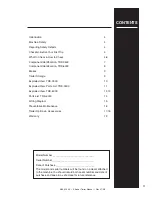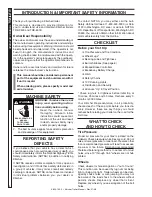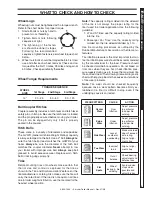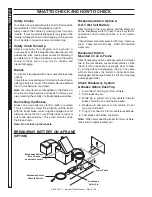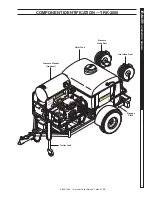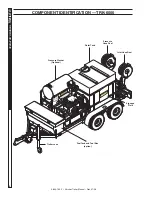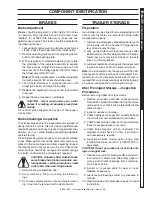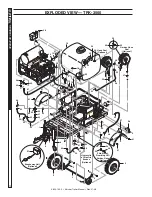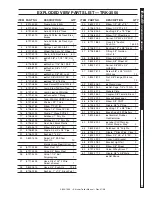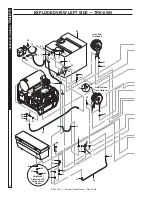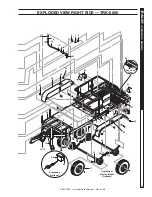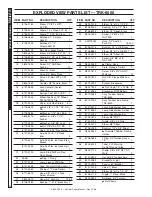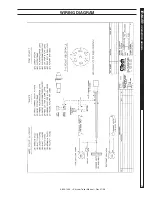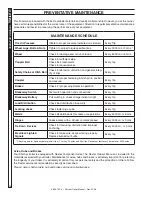
9.800-199.0 • Kärcher Trailer Manual • Rev. 01/08
5
TRAILER
OPERA
TOR’S MANU
AL
Wheel lugs
Wheel lug nuts must be tightened with a torque wrench.
Refer to the chart below for proper torque.
1. Start all bolts or nuts by hand to
prevent cross threading.
2. Tighten bolts or nuts following
sequence at right.
. The tightening of the fasten-
ers should be done in stages.
Following the recommended
sequence, tighten fasteners per wheel torque chart
below.
4. Wheel nuts/bolts should be torqued before first road
use and after each wheel removal. Check and re-
torque after the first 10 miles, 25 miles and again at
50 miles. Check periodically thereafter.
Wheel Torque requirements
Ball Coupler hitches
Coupler assembly includes a latch lever and latch lever
safety pin or hitch pin. Be sure the latch lever is locked
and the pin properly secured before moving your trailer.
The pin can be engaged fully only if ball is properly
seated in the coupler.
hitch Balls
These come in a variety of diameters and capacities.
The GVWR (General Vehicle Weight Rating) capacity
is always stamped on the ball. Use a 2" ball.
always
be
sure the hitch ball at least matches the GVWR of your
trailer.
always
be sure the diameter of the hitch ball
matches the coupler diameter.
Never
attempt to tow
your trailer with improper size ball.
always
keep ball
greased to avoid excessive wear. Replace worn hitch
ball or locking dogs promptly.
Tires
Before mounting tires onto wheels make certain that
the rim size and contour is approved for the tire as
shown in the Tire and Rim Association Yearbook or the
tire manufacturer’s catalog. Also make sure the tire will
carry the rated load. If the load is not equal on all tires
due to trailer weight distribution, use the tire rated for the
heaviest wheel position.
Note:
The capacity rating molded into the sidewall
of the tire is not always the proper rating for the
tire if used in a trailer application. Use the following
guideline:
1. LT and ST tires: use the capacity rating molded
into the tire.
2. Passenger Car Tires: Use the capacity rating
molded into the tire sidewall divided by 1.10.
Use tire mounting procedures as outlined by the
Rubber Manufacturer’s Association or the tire manu-
facturers.
Tire inflation pressure is the most important factor in
tire life. Inflation pressure should be as recommended
by the manufacturer for the load. Pressure should
be checked cold before operation. Do not bleed air
from tires when they are hot. Check inflation pres-
sure weekly during use to insure the maximum tire
life and tread wear. The following tire wear diagnostic
chart will help you pinpoint the causes and solutions
of tire wear problems.
Note:
Tire wear should be checked frequently
because once a wear pattern becomes firmly es-
tablished in a tire it is difficult to stop, even if the
underlying cause is corrected.
Wheel
Size
TOrqUe SeqUeNCe
1st Stage
2nd Stage
3rd Stage
14"
20 - 25
50 - 60
90 - 120
Wear PaTTerN
CaUSe
aCTiON
ACTION
Center
Wear
Over
Inflation
Adjust pressure
to particular
load per tire
catalog.
edge
Wear
Under
Inflation
Adjust pressure
to particular
load per tire
catalog.
Side Wear
Loss of
camber or
overloading
Make sure load
doesn't exceed
axle rating.
Align at align-
ment shop.
Toe Wear
Incorrect
toe-in
Align at align-
ment shop.
Cupping
Out of
balance
Check bearing
adjustment and
balance tires.
flat
Spots
Wheel
lockup & tire
skidding
Avoid sudden
stops when
possible and
adjust brakes.
WhaT TO CheCK aND hOW TO CheCK
1
2
3
4
5



